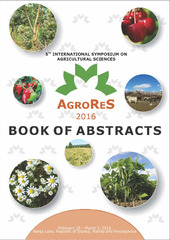Приказ основних података о документу
Characterization of common bean (Phaseolus vulgaris L.) landraces through basic morphological characteristics and protein markers
| dc.creator | Vasić, Mirjana | |
| dc.creator | Todorović, Vida | |
| dc.creator | Petrović, Gordana | |
| dc.creator | Nikolić, Zorica | |
| dc.creator | Đurić, Gordana | |
| dc.creator | Savić, Aleksandra | |
| dc.creator | Dimitrijević, Miodrag | |
| dc.date.accessioned | 2022-08-01T09:23:03Z | |
| dc.date.available | 2022-08-01T09:23:03Z | |
| dc.date.issued | 2016 | |
| dc.identifier.isbn | 978-99938-93-37-0 | |
| dc.identifier.uri | http://fiver.ifvcns.rs/handle/123456789/2950 | |
| dc.description.abstract | The Balkan Peninsula is the region of a great diversity of dry beans and green beans due to its transient position, differen tsoil and climate conditions and presence of many nations. Beans were introduced to the region from two directions: Turkey and Western Europe; and from two centres of origin: Mesoamerican and Andean. Landraces of dry beans and green beans can still be found on small farms. In total 26 landraces were collected in the area of Republika Srpska and basic traits- stalk growth type, pod characteristics (colour, shape), and grain characteristics (colour of seed coat, shape and seed size) were evaluated after the collection and storage. In addition phaseolin type (protein marker) was determined. 14 accessions had indeterminate growth, and12 accessions determinate. Two indeterminate green beans, belonging to the cultivar Trebinjska Roga, have typical green flat pods and different grain colour. They were compared to cultivars of indeterminate green beans from Serbia - Tisa and Resava. Indeterminate beans differed by seed size and coloured seed coat. The following landraces were tested together with high beans: landraces of indeterminate beans from Macedonia (9 samples), cultivars Levač (Serbia) and Ludogorje (Bulgaria). Determinate accessions had coloured grain and could be used both as dry beans and green beans, which is a common trait found in landraces and old varieties. They were compared to cultivars (6) from Serbia and landraces (8) from the collection of beans of the Institute of Field and Vegetable Crops, Novi Sad. Results of the biochemical analyis showed that the T type of phaseolin was prevalent and present in 24 of 26 landraces tested from Republika Srpska, indicating their Andean gene centre of origin. Results showed that accessions from both centres of origin are grown in our agro-climate area. Accessions with S type of phaseolin (in this case newly bred cultivars) are grown increasingly, which could be related to the temperature increase during the growing season. | sr |
| dc.language.iso | en | sr |
| dc.publisher | Banja Luka : University of Banja Luka, Faculty of Agriculture | sr |
| dc.rights | openAccess | sr |
| dc.rights.uri | https://creativecommons.org/licenses/by/4.0/ | |
| dc.source | Book of Abstracts, 5th International Symposium on Agricultural Sciences "AgroRes 2016", 29 February-3 March 2016, Banja Luka | sr |
| dc.subject | Phaseolus vulgaris | sr |
| dc.subject | morphological characteristics | sr |
| dc.subject | phaseolin | sr |
| dc.subject | beans | sr |
| dc.subject | protein markers | sr |
| dc.title | Characterization of common bean (Phaseolus vulgaris L.) landraces through basic morphological characteristics and protein markers | sr |
| dc.type | conferenceObject | sr |
| dc.rights.license | BY | sr |
| dc.citation.epage | 108 | |
| dc.citation.spage | 108 | |
| dc.identifier.fulltext | http://fiver.ifvcns.rs/bitstream/id/8253/Agrores_2016_Vasic.pdf | |
| dc.identifier.rcub | https://hdl.handle.net/21.15107/rcub_fiver_2950 | |
| dc.type.version | publishedVersion | sr |


